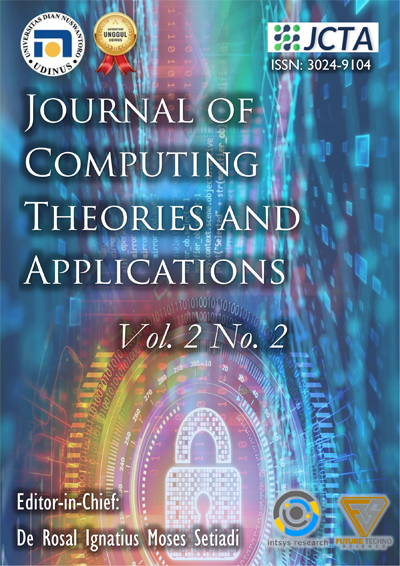IoT Security Using Machine Learning Methods with Features Correlation
DOI:
https://doi.org/10.62411/jcta.11179Keywords:
Botnet, DDoS, IoT, Feature extraction, Feature selection, Machine learning, MalwareAbstract
The Internet of Things (IoT) is an innovative technology that makes our environment smarter, with IoT devices as an integral part of home automation. Smart home systems are becoming increasingly popular as an IoT service in the home that connects via a network. Due to the security weakness of many devices, the malware is targeting IoT devices. After being infected with malicious attacks on smart devices, they act like bots that the intruders can control. Machine learning methods can assist in improving the attack detection process for these devices. However, the irrelevant features raise the computation time as well as affect the detection accuracy in the processing with many features. We proposed a machine learning-based IoT security framework using feature correlation. The feature extraction scheme, one-hot feature encoding, correlation feature selection, and attack detection implement an active detection mechanism. The results show that the implemented framework is not only for effective detection but also for lightweight performance. The proposed system outperforms the results with the selected features, which have almost 100% detection accuracy. It is also approved that the proposed system using CART is more suitable in terms of processing time and detection accuracy.References
M. Kuzin, Y. Shmelev, and V. Kuskov, “New trends in the world of IoT threats,” Securelist by Kaspersky, 2018. https://securelist.com/new-trends-in-the-world-of-iot-threats/87991/ (accessed Jul. 01, 2024).
Cisco, “Cisco Visual Networking Index: Forecast and Trends, 2017–2022,” 2022. [Online]. Available: https://cloud.report/Resources/Whitepapers/eea79d9b-9fe3-4018-86c6-3d1df813d3b8_white-paper-c11-741490.pdf
CyberEdge Group, “2023 Cyberthreat Defense Report,” 2023. [Online]. Available: https://www.cyberedgegroup.com/wp-content/uploads/2023/04/CyberEdge-2023-CDR-Report-v1.0.pdf
ASEAN IVO, “ASEAN-Wide Cyber-Security Research Testbed.” https://www.nict.go.jp/en/asean_ivo/ASEAN_IVO_2020_Project03.html (accessed Jul. 02, 2024).
N. Anjum and M. R. Chowdhury, “International Journal of Advanced Research in Computer and Communication Engineering,” SSRN Electron. J., 2024, doi: 10.2139/ssrn.4847308.
S. D. Bay, D. Kibler, M. J. Pazzani, and P. Smyth, “The UCI KDD archive of large data sets for data mining research and experimentation,” ACM SIGKDD Explor. Newsl., vol. 2, no. 2, pp. 81–85, Dec. 2000, doi: 10.1145/380995.381030.
R. Kumar and D. Sharma, “HyINT: Signature-Anomaly Intrusion Detection System,” in 2018 9th International Conference on Computing, Communication and Networking Technologies (ICCCNT), Jul. 2018, pp. 1–7. doi: 10.1109/ICCCNT.2018.8494088.
M. I. Akazue, I. A. Debekeme, A. E. Edje, C. Asuai, and U. J. Osame, “UNMASKING FRAUDSTERS: Ensemble Features Selection to Enhance Random Forest Fraud Detection,” J. Comput. Theor. Appl., vol. 1, no. 2, pp. 201–211, Dec. 2023, doi: 10.33633/jcta.v1i2.9462.
S. Taheri and M. Mammadov, “Learning the naive Bayes classifier with optimization models,” Int. J. Appl. Math. Comput. Sci., vol. 23, no. 4, pp. 787–795, Dec. 2013, doi: 10.2478/amcs-2013-0059.
H. Bennadi, K. Ibrahimi, and A. Benslimane, “Improving the Intrusion Detection System for NSL-KDD Dataset based on PCA-Fuzzy Clustering-KNN,” in 2018 6th International Conference on Wireless Networks and Mobile Communications (WINCOM), Oct. 2018, pp. 1–6. doi: 10.1109/WINCOM.2018.8629718.
G. Meena and R. R. Choudhary, “A review paper on IDS classification using KDD 99 and NSL KDD dataset in WEKA,” in 2017 International Conference on Computer, Communications and Electronics (Comptelix), Jul. 2017, pp. 553–558. doi: 10.1109/COMPTELIX.2017.8004032.
J. Alsamiri and K. Alsubhi, “Internet of Things Cyber Attacks Detection using Machine Learning,” Int. J. Adv. Comput. Sci. Appl., vol. 10, no. 12, 2019, doi: 10.14569/IJACSA.2019.0101280.
A. Ganesan, P. Parameshwarappa, A. Peshave, Z. Chen, and T. Oates, “Extending Signature-based Intrusion Detection Systems WithBayesian Abductive Reasoning,” ArXiv. Mar. 28, 2019. [Online]. Available: http://arxiv.org/abs/1903.12101
S. A. R. Shah and B. Issac, “Performance comparison of intrusion detection systems and application of machine learning to Snort system,” Futur. Gener. Comput. Syst., vol. 80, pp. 157–170, Mar. 2018, doi: 10.1016/j.future.2017.10.016.
Y. Sugianela and T. Ahmad, “Pearson Correlation Attribute Evaluation-based Feature Selection for Intrusion Detection System,” in 2020 International Conference on Smart Technology and Applications (ICoSTA), Feb. 2020, pp. 1–5. doi: 10.1109/ICoSTA48221.2020.1570613717.
N. Abdalgawad, A. Sajun, Y. Kaddoura, I. A. Zualkernan, and F. Aloul, “Generative Deep Learning to Detect Cyberattacks for the IoT-23 Dataset,” IEEE Access, vol. 10, pp. 6430–6441, 2022, doi: 10.1109/ACCESS.2021.3140015.
N. Saini, V. Bhat Kasaragod, K. Prakasha, and A. K. Das, “A hybrid ensemble machine learning model for detecting APT attacks based on network behavior anomaly detection,” Concurr. Comput. Pract. Exp., vol. 35, no. 28, Dec. 2023, doi: 10.1002/cpe.7865.
M. Keshk, N. Koroniotis, N. Pham, N. Moustafa, B. Turnbull, and A. Y. Zomaya, “An explainable deep learning-enabled intrusion detection framework in IoT networks,” Inf. Sci. (Ny)., vol. 639, p. 119000, Aug. 2023, doi: 10.1016/j.ins.2023.119000.
A. R. E.-M. Baahmed, G. Andresini, C. Robardet, and A. Appice, “Using Graph Neural Networks for the Detection and Explanation of Network Intrusions,” in ECML PKDD International Workshop on eXplainable Knowledge Discovery in Data Mining, 2023. [Online]. Available: http://xkdd2023.isti.cnr.it/papers/422.pdf
Y. N. Kunang, S. Nurmaini, D. Stiawan, and B. Y. Suprapto, “An end-to-end intrusion detection system with IoT dataset using deep learning with unsupervised feature extraction,” Int. J. Inf. Secur., vol. 23, no. 3, pp. 1619–1648, Jun. 2024, doi: 10.1007/s10207-023-00807-7.
K. Ren, Y. Zeng, Z. Cao, and Y. Zhang, “ID-RDRL: a deep reinforcement learning-based feature selection intrusion detection model,” Sci. Rep., vol. 12, no. 1, p. 15370, Sep. 2022, doi: 10.1038/s41598-022-19366-3.
Wireshark Foundation, “tshark(1) Manual Page.” https://www.wireshark.org/docs/man-pages/tshark.html (accessed Jul. 03, 2024).
Canadian Institute for Cybersecurity, “CICFlowMeter (formerly ISCXFlowMeter),” University of New Brunswick. https://www.unb.ca/cic/research/applications.html.
The Zeek Project, “Zeek: Network Security Monitoring,” Zeek Project. https://zeek.org
F. Pedregosa et al., “Scikit-learn: Machine Learning in Python,” J. Mach. Learn. Res., vol. 12, pp. 2825–2830, 2011, Accessed: Feb. 17, 2020. [Online]. Available: http://scikit-learn.sourceforge.net.
D. Freedman, R. Pisani, and R. Purves, Statistics (International Student Edition), 4th ed. University of California, Berkeley; Boulder, Colorado: WW Norton, 2007.
L. Breiman, J. H. Friedman, R. A. Olshen, and C. J. Stone, Classification And Regression Trees. Routledge, 2017. doi: 10.1201/9781315139470.
S. Garcia, A. Parmisano, and M. J. Erquiaga, “IoT-23: A labeled dataset with malicious and benign IoT network traffic,” Stratosphere Lab, 2020. https://www.stratosphereips.org/datasets-iot23
D. R. I. M. Setiadi, S. Widiono, A. N. Safriandono, and S. Budi, “Phishing Website Detection Using Bidirectional Gated Recurrent Unit Model and Feature Selection,” J. Futur. Artif. Intell. Technol., vol. 2, no. 1, pp. 75–83, 2024, doi: 10.62411/faith.2024-15.
F. Omoruwou, A. A. Ojugo, and S. E. Ilodigwe, “Strategic Feature Selection for Enhanced Scorch Prediction in Flexible Polyurethane Form Manufacturing,” J. Comput. Theor. Appl., vol. 1, no. 3, pp. 346–357, Feb. 2024, doi: 10.62411/jcta.9539.
L. Yue, “Machine Learning and Deep Learning Methods for Better Anomaly Detection in IoT-23 Dataset Cybersecurity,” GitHub repository, 2021. https://github.com/yliang725/Anomaly-Detection-IoT23
N. A. Stoian, “Machine Learning for anomaly detection in IoT networks : Malware analysis,” University of Twente, 2020. [Online]. Available: https://purl.utwente.nl/essays/81979
Downloads
Published
How to Cite
Issue
Section
License
Copyright (c) 2024 Chaw Su Htwe, Zin Thu Thu Myint, Yee Mon Thant

This work is licensed under a Creative Commons Attribution 4.0 International License.















